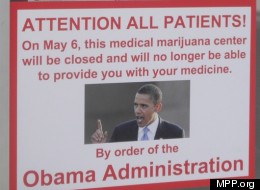Medical Marijuana: Obama's War On Pot Ramps Up In Colorado, Key Swing State
Thursday, May 10, 2012
Title 21. Food and Drugs. Chapter 13. DrugAbusePrevention and Control, Subchapter I, Control and Enforcement. Part B. Authority to Control; Standards and Schedules.
Sec. 811. Authority and criteria for classification of substances
Under 21 USC 811 the AttorneyGeneral has the authority to add to, remove from, or transfer controlled substances between the regulatory schedules established by the ControlledSubstancesAct. This process is known as a rulemaking procedure and may be initiated by the AttorneyGeneral, the Secretary of HHS, or on the petition of any interested party. (21 USC 811 (a))
At the initiation of scheduling proceedings the AttorneyGeneral gathers the necessary data and requests from the SecretaryOfHHS a scientific and medical evaluation of all available evidence as well as a recommendation on the appropriate scheduling for the drug or substance in question. (21 USC 811 (b))
This evaluation will consider 8 specific factors in making findings to satisfy the criteria for scheduling established in Section 812 regarding accepted medical use, safety for use, abuse potential, and dependence liability. InOtherWords the factors listed in 811(c) are to be used to evaluate the scientific record to assess the criteria established for each respective schedule of the CSA.
21 USC 811(c) Factors determinative of control or removal from schedules.
“In making any finding under subsection (a) of section 812 of this title, the AttorneyGeneral shall consider the following factors with respect to each drug or other substance proposed to be controlled or removed from the schedules:
(1) Its actual or relative potential for abuse.
(2) Scientific evidence of its pharmacological effect, if known.
(3) The state of current scientific knowledge regarding the drug or other substance.
(4) Its history and current pattern of abuse.
(5) The scope, duration, and significance of abuse.
(6) What, if any, risk there is to the PublicHealth.
(7) Its psychic or physiological dependence liability.
(8) Whether the substance is an immediate precursor of a substance already controlled under this subchapter.”
Sec. 812. Schedules of controlled substances.
There are five schedules of controlled substances. The findings required for each of the schedules involve the following issues: potential for abuse, currently accepted medical use in treatment in the United States, safety for use under medical supervision, and the drug’s dependence liability. Schedule I drugs are characterized by a high potential for abuse and a lack of accepted medical use. Schedule II drugs have a high potential for abuse but also have an accepted medical use. The remaining schedules all require an accepted medical use. Schedule III drugs have a lower potential for abuse and dependence liability than Schedule I and II drugs. Schedule IV drugs have a lower potential for abuse and dependence liability than Schedule III drugs, and Schedule V drugs have a lower potential for abuse than Schedule IV drugs. (21 USC 812)
KEEP READING
Read the Article at HuffingtonPost











0 comments:
Post a Comment